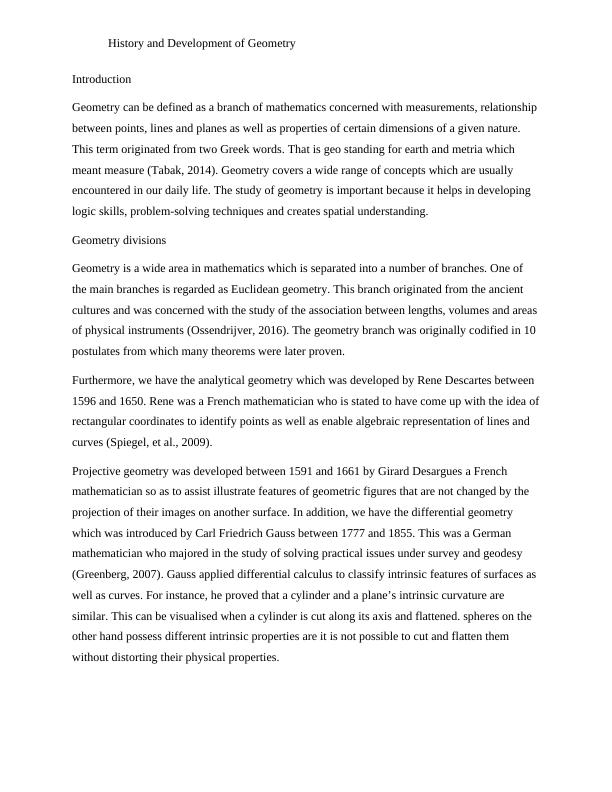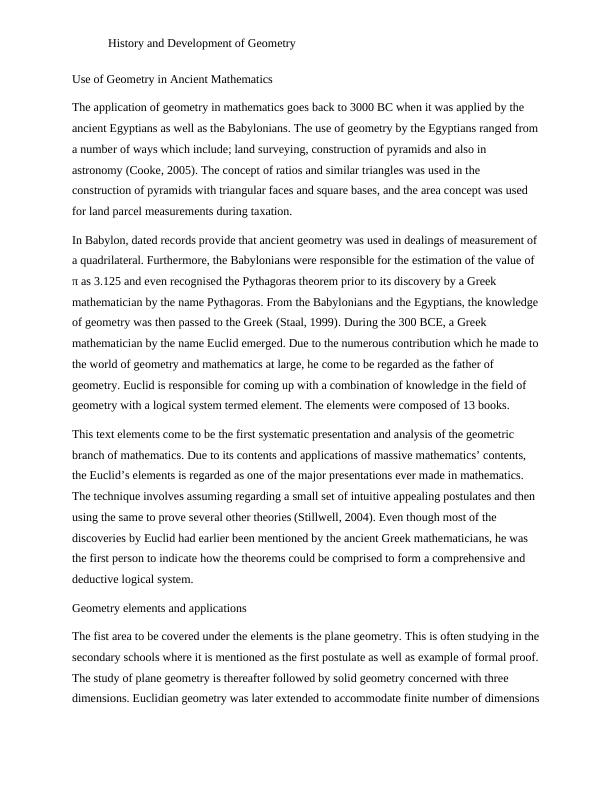History and Development of Geometry
Choose a topic related to mathematics, examine existing literature, and produce a 9-page report on the findings.
9 Pages2886 Words411 Views
Added on 2023-06-03
About This Document
This article explores the history and development of geometry from ancient mathematicians to modern society. It covers the different branches of geometry and its applications in various fields. It also discusses the importance of studying geometry.
History and Development of Geometry
Choose a topic related to mathematics, examine existing literature, and produce a 9-page report on the findings.
Added on 2023-06-03
ShareRelated Documents
History and Development of Geometry
History and Development of Geometry
Institution Name
Student Name
Date of Submission
History and Development of Geometry
Institution Name
Student Name
Date of Submission

History and Development of Geometry
Introduction
Geometry can be defined as a branch of mathematics concerned with measurements, relationship
between points, lines and planes as well as properties of certain dimensions of a given nature.
This term originated from two Greek words. That is geo standing for earth and metria which
meant measure (Tabak, 2014). Geometry covers a wide range of concepts which are usually
encountered in our daily life. The study of geometry is important because it helps in developing
logic skills, problem-solving techniques and creates spatial understanding.
Geometry divisions
Geometry is a wide area in mathematics which is separated into a number of branches. One of
the main branches is regarded as Euclidean geometry. This branch originated from the ancient
cultures and was concerned with the study of the association between lengths, volumes and areas
of physical instruments (Ossendrijver, 2016). The geometry branch was originally codified in 10
postulates from which many theorems were later proven.
Furthermore, we have the analytical geometry which was developed by Rene Descartes between
1596 and 1650. Rene was a French mathematician who is stated to have come up with the idea of
rectangular coordinates to identify points as well as enable algebraic representation of lines and
curves (Spiegel, et al., 2009).
Projective geometry was developed between 1591 and 1661 by Girard Desargues a French
mathematician so as to assist illustrate features of geometric figures that are not changed by the
projection of their images on another surface. In addition, we have the differential geometry
which was introduced by Carl Friedrich Gauss between 1777 and 1855. This was a German
mathematician who majored in the study of solving practical issues under survey and geodesy
(Greenberg, 2007). Gauss applied differential calculus to classify intrinsic features of surfaces as
well as curves. For instance, he proved that a cylinder and a plane’s intrinsic curvature are
similar. This can be visualised when a cylinder is cut along its axis and flattened. spheres on the
other hand possess different intrinsic properties are it is not possible to cut and flatten them
without distorting their physical properties.
Introduction
Geometry can be defined as a branch of mathematics concerned with measurements, relationship
between points, lines and planes as well as properties of certain dimensions of a given nature.
This term originated from two Greek words. That is geo standing for earth and metria which
meant measure (Tabak, 2014). Geometry covers a wide range of concepts which are usually
encountered in our daily life. The study of geometry is important because it helps in developing
logic skills, problem-solving techniques and creates spatial understanding.
Geometry divisions
Geometry is a wide area in mathematics which is separated into a number of branches. One of
the main branches is regarded as Euclidean geometry. This branch originated from the ancient
cultures and was concerned with the study of the association between lengths, volumes and areas
of physical instruments (Ossendrijver, 2016). The geometry branch was originally codified in 10
postulates from which many theorems were later proven.
Furthermore, we have the analytical geometry which was developed by Rene Descartes between
1596 and 1650. Rene was a French mathematician who is stated to have come up with the idea of
rectangular coordinates to identify points as well as enable algebraic representation of lines and
curves (Spiegel, et al., 2009).
Projective geometry was developed between 1591 and 1661 by Girard Desargues a French
mathematician so as to assist illustrate features of geometric figures that are not changed by the
projection of their images on another surface. In addition, we have the differential geometry
which was introduced by Carl Friedrich Gauss between 1777 and 1855. This was a German
mathematician who majored in the study of solving practical issues under survey and geodesy
(Greenberg, 2007). Gauss applied differential calculus to classify intrinsic features of surfaces as
well as curves. For instance, he proved that a cylinder and a plane’s intrinsic curvature are
similar. This can be visualised when a cylinder is cut along its axis and flattened. spheres on the
other hand possess different intrinsic properties are it is not possible to cut and flatten them
without distorting their physical properties.

History and Development of Geometry
Use of Geometry in Ancient Mathematics
The application of geometry in mathematics goes back to 3000 BC when it was applied by the
ancient Egyptians as well as the Babylonians. The use of geometry by the Egyptians ranged from
a number of ways which include; land surveying, construction of pyramids and also in
astronomy (Cooke, 2005). The concept of ratios and similar triangles was used in the
construction of pyramids with triangular faces and square bases, and the area concept was used
for land parcel measurements during taxation.
In Babylon, dated records provide that ancient geometry was used in dealings of measurement of
a quadrilateral. Furthermore, the Babylonians were responsible for the estimation of the value of
π as 3.125 and even recognised the Pythagoras theorem prior to its discovery by a Greek
mathematician by the name Pythagoras. From the Babylonians and the Egyptians, the knowledge
of geometry was then passed to the Greek (Staal, 1999). During the 300 BCE, a Greek
mathematician by the name Euclid emerged. Due to the numerous contribution which he made to
the world of geometry and mathematics at large, he come to be regarded as the father of
geometry. Euclid is responsible for coming up with a combination of knowledge in the field of
geometry with a logical system termed element. The elements were composed of 13 books.
This text elements come to be the first systematic presentation and analysis of the geometric
branch of mathematics. Due to its contents and applications of massive mathematics’ contents,
the Euclid’s elements is regarded as one of the major presentations ever made in mathematics.
The technique involves assuming regarding a small set of intuitive appealing postulates and then
using the same to prove several other theories (Stillwell, 2004). Even though most of the
discoveries by Euclid had earlier been mentioned by the ancient Greek mathematicians, he was
the first person to indicate how the theorems could be comprised to form a comprehensive and
deductive logical system.
Geometry elements and applications
The fist area to be covered under the elements is the plane geometry. This is often studying in the
secondary schools where it is mentioned as the first postulate as well as example of formal proof.
The study of plane geometry is thereafter followed by solid geometry concerned with three
dimensions. Euclidian geometry was later extended to accommodate finite number of dimensions
Use of Geometry in Ancient Mathematics
The application of geometry in mathematics goes back to 3000 BC when it was applied by the
ancient Egyptians as well as the Babylonians. The use of geometry by the Egyptians ranged from
a number of ways which include; land surveying, construction of pyramids and also in
astronomy (Cooke, 2005). The concept of ratios and similar triangles was used in the
construction of pyramids with triangular faces and square bases, and the area concept was used
for land parcel measurements during taxation.
In Babylon, dated records provide that ancient geometry was used in dealings of measurement of
a quadrilateral. Furthermore, the Babylonians were responsible for the estimation of the value of
π as 3.125 and even recognised the Pythagoras theorem prior to its discovery by a Greek
mathematician by the name Pythagoras. From the Babylonians and the Egyptians, the knowledge
of geometry was then passed to the Greek (Staal, 1999). During the 300 BCE, a Greek
mathematician by the name Euclid emerged. Due to the numerous contribution which he made to
the world of geometry and mathematics at large, he come to be regarded as the father of
geometry. Euclid is responsible for coming up with a combination of knowledge in the field of
geometry with a logical system termed element. The elements were composed of 13 books.
This text elements come to be the first systematic presentation and analysis of the geometric
branch of mathematics. Due to its contents and applications of massive mathematics’ contents,
the Euclid’s elements is regarded as one of the major presentations ever made in mathematics.
The technique involves assuming regarding a small set of intuitive appealing postulates and then
using the same to prove several other theories (Stillwell, 2004). Even though most of the
discoveries by Euclid had earlier been mentioned by the ancient Greek mathematicians, he was
the first person to indicate how the theorems could be comprised to form a comprehensive and
deductive logical system.
Geometry elements and applications
The fist area to be covered under the elements is the plane geometry. This is often studying in the
secondary schools where it is mentioned as the first postulate as well as example of formal proof.
The study of plane geometry is thereafter followed by solid geometry concerned with three
dimensions. Euclidian geometry was later extended to accommodate finite number of dimensions

End of preview
Want to access all the pages? Upload your documents or become a member.
